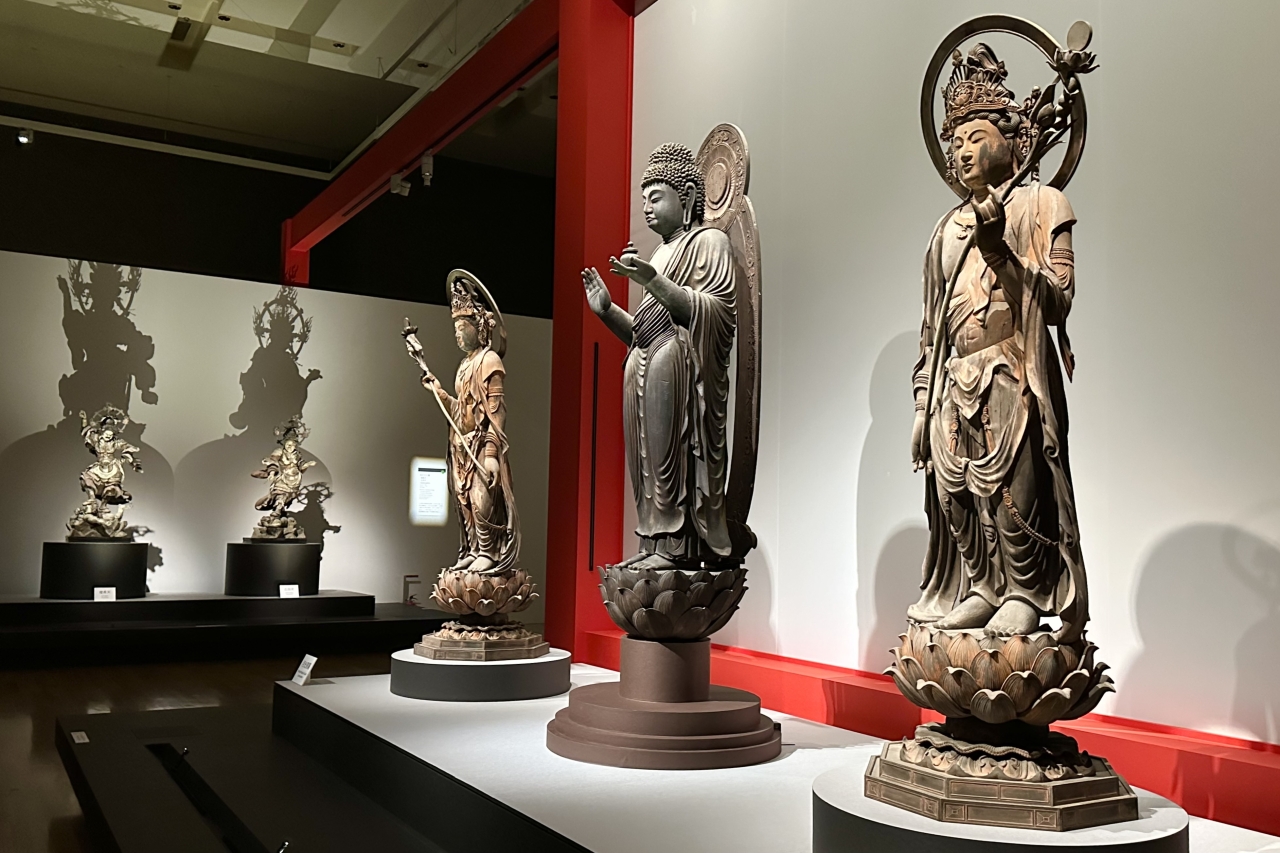
Article provided by: Taito Cultural Marche
The special exhibition “Jingo-ji Temple – Kukai and the Origins of Esoteric Shingon Buddhism” commemorating the 1200th anniversary of its founding has opened at the Tokyo National Museum, showcasing the treasures of Jingo-ji Temple in Kyoto, the birthplace of Kobo Daishi Kukai and Esoteric Shingon Buddhism . The exhibition will run until Sunday, September 8, 2024.
*Some of the works on display will be changed during the exhibition period.
Early exhibition: July 17th (Wednesday) – August 12th (Monday/Closed)
Late exhibition: August 14th (Wednesday) – September 8th (Sunday)
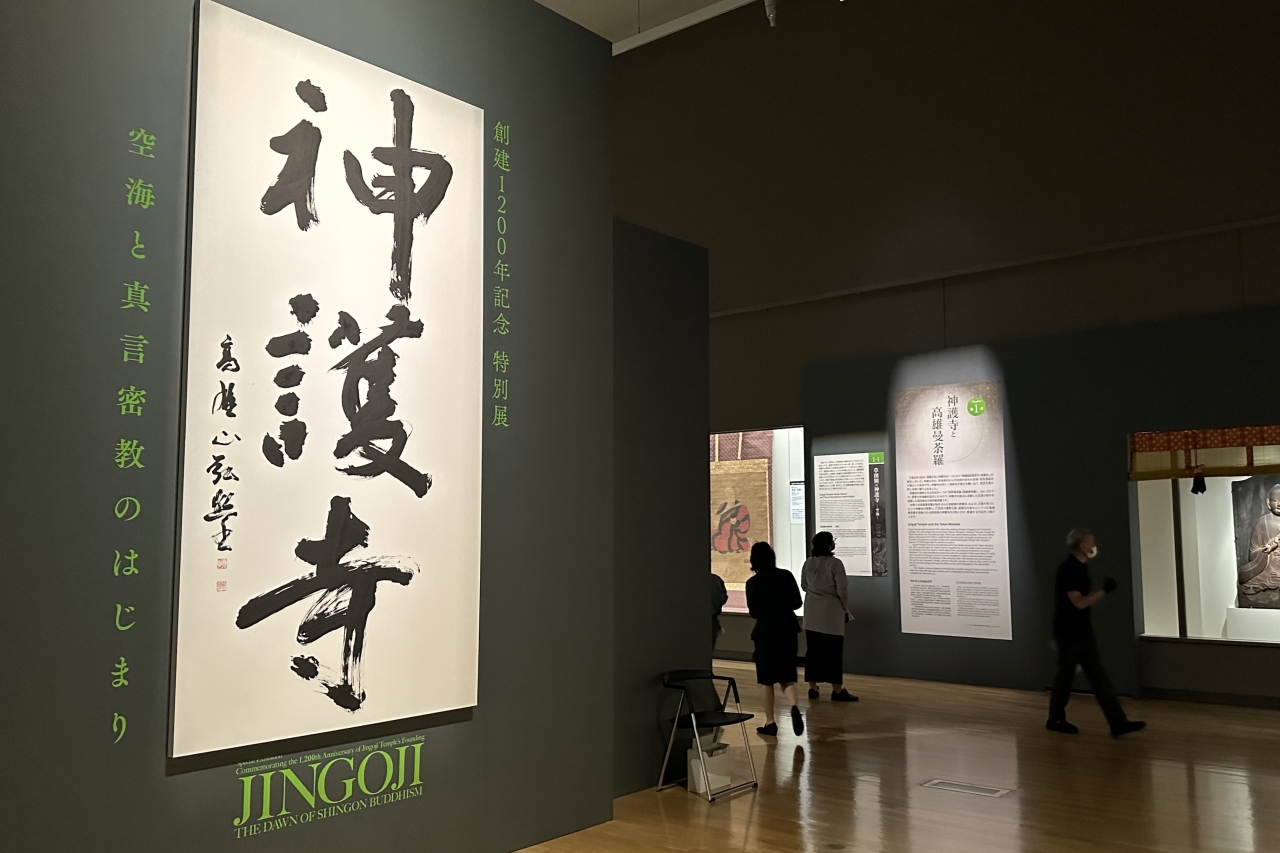
The large “Jingo-ji Temple” sign at the entrance was written by the temple’s chief priest, Taniuchi Kosho.
A sacred place for Esoteric Shingon Buddhism, where 1200 years of treasures are gathered together
Jingo-ji Temple (Jingokokuzo Shingon-ji Temple), located in Takao, Kyoto, was established in 824 when two temples, Takao-san-ji Temple and Shingan-ji Temple, merged. Takao-san-ji Temple was the family temple of Wake no Kiyomaro, who proposed moving the capital to Heian, and was the residence of Kukai (774-835), who had systematically studied esoteric Buddhism in Chang’an, the capital of the Tang Dynasty, after returning to Japan, and where he built the foundations of Shingon Esoteric Buddhism.
After Kukai passed away, the temple fell into ruin due to fires and other incidents, but was restored thanks to the efforts of the Shingon monk Monkaku, who was supported by Emperor Goshirakawa and Minamoto no Yoritomo. Even after that, the temple has endured many crises, including the Onin War, the destruction of Buddhism and Shingon temple land during the Meiji Restoration, and more, but it has continued to preserve the light of the Dharma to this day.

Important Cultural Property “Statue of Kobo Daishi” Kamakura period, 14th century, owned by Jingoji Temple, Kyoto, on display throughout the year
This exhibition is being held to commemorate the 1,200th anniversary of the founding of Jingo-ji Temple and the 1,250th anniversary of the birth of Kukai in 2024.
The core of the exhibition are the treasures that Jingo-ji Temple has protected and passed down over the turbulent years of 1,200 years, such as the principal image of the temple, the National Treasure “Standing Statue of Yakushi Nyorai,” known as one of the greatest masterpieces in the history of Japanese sculpture, and the National Treasure “Ryokai Mandala (Takao Mandala),” associated with Kukai, which has been restored over a period of six years. This exhibition is unparalleled in both quality and quantity, showcasing around 100 masterpieces of Japanese art, not just Buddhist art, including 17 National Treasures and 44 Important Cultural Properties.
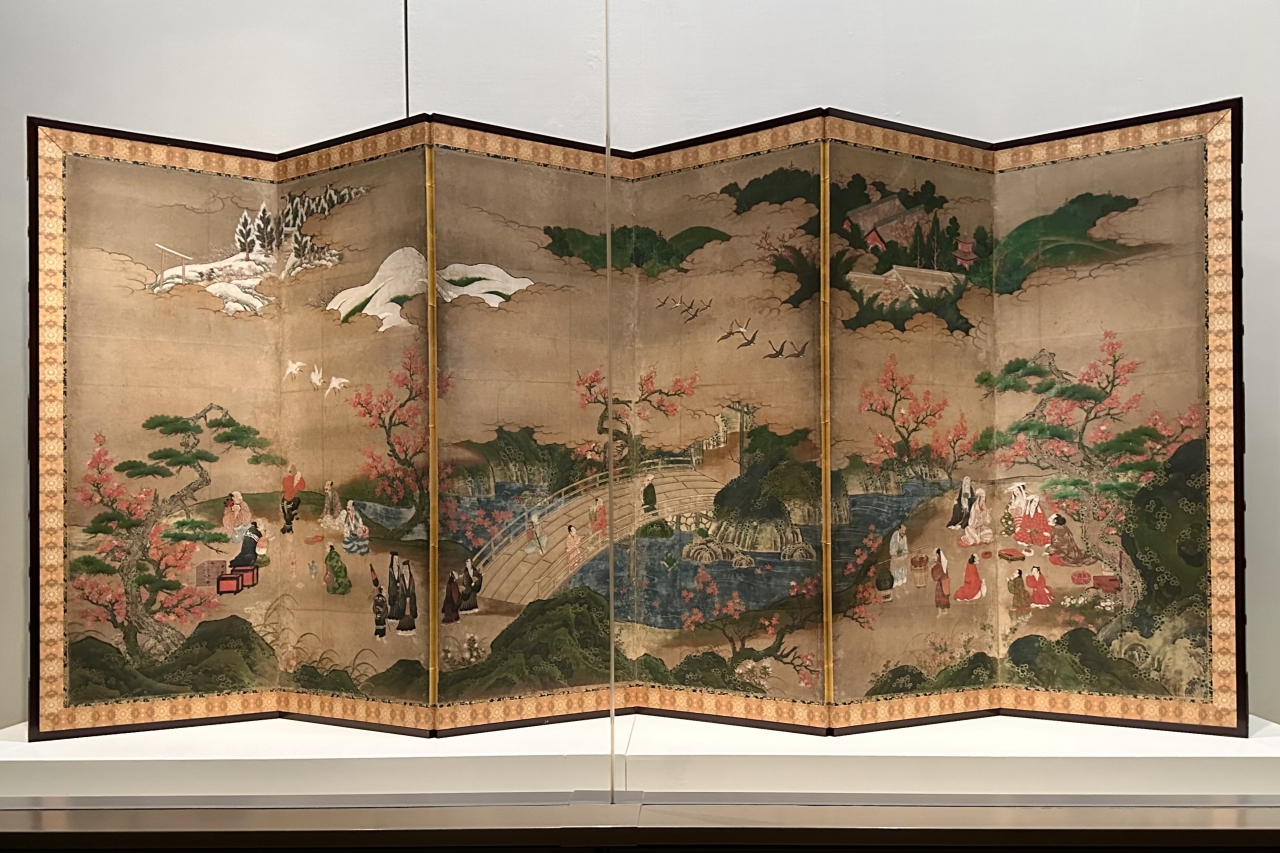
National Treasure “Maple View Screen” by Kano Hideyori, Muromachi to Azuchi-Momoyama period, 16th century, Tokyo National Museum, first half of exhibition
The exhibits are structured to trace the history of Jingo-ji Temple.
At the beginning of the exhibition, the exhibition symbolically features the Maple Viewing Screen, which depicts people enjoying a banquet with maple leaves lined up along the clear Kiyotaki River that flows through Takao, with the sacred Jingo-ji Temple overlooking the clouds. The display conveys the atmosphere of Jingo-ji Temple, which has long been beloved as a scenic spot for viewing autumn leaves and continues to fascinate people today with its beautiful scenery.

National Treasure “Gilded bronze esoteric Buddhist ritual implements (Vajra plate, five-pronged bell, five-pronged vajra)” China, Tang Dynasty, 8th to 9th century, kept at Kyoogokoku-ji Temple (Toji Temple) in Kyoto, on display throughout the year / These ritual implements are said to have been bestowed upon Kukai by his teacher, Huiguo.

National Treasure “Kanjo Calendar” by Kukai, Heian period, Kōnin 3 (812), owned by Jingoji Temple, Kyoto, exhibition period: July 17th to August 25th / A list of those who received the kanjo ceremony. You can see the free and open calligraphy style used in daily life by Kukai, who is counted among the three great calligraphers of the time.
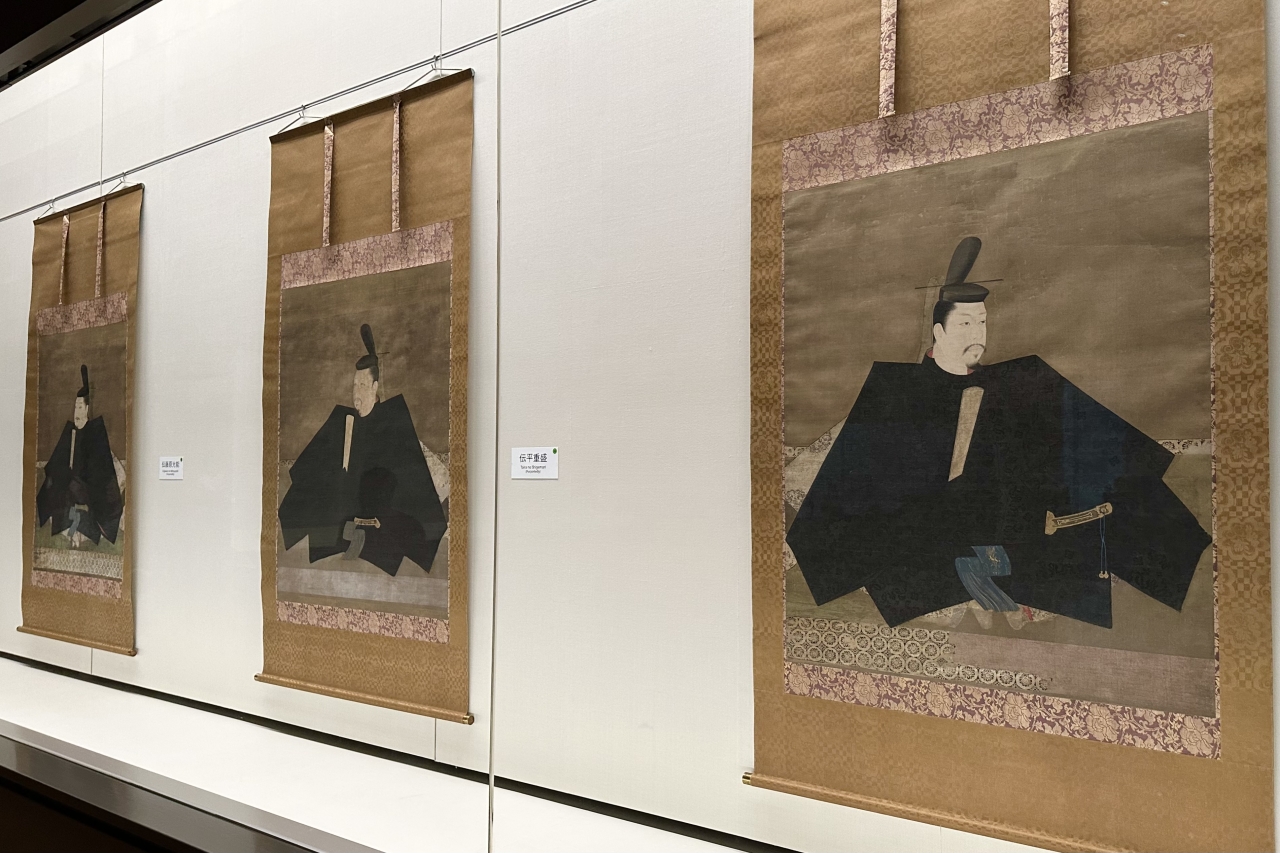
On the right is the National Treasure “Portrait of Minamoto no Yoritomo” from the Kamakura period, 13th century, owned by Jingo-ji Temple in Kyoto, on display in the first half of the exhibition. This life-size portrait of Yoritomo, who supported Jingo-ji Temple, is a masterpiece of Japanese portraiture, with every single hair carefully depicted, from the hairline to the eyelashes.
There are many temple treasures related to the national treasure “Takao Mandala”!
The highlight of the first half of the exhibition is the National Treasure “Ryokai Mandala (Takao Mandala),” the oldest existing Ryokai Mandala in Japan. Of the two mandalas, the “Taizōkai” will be exhibited in the first half, and the “Konjōkai” in the second half, alternately.

National Treasure “Ryokai Mandala (Takao Mandala)” Heian period, 9th century, owned by Jingoji Temple, Kyoto. Image is from the early exhibition at “Taizōkai”
The Ryōkai Mandala is a pair of two scrolls that visualize the universe centered on Dainichi Nyorai as preached in Shingon Esoteric Buddhism, that is, the two worldviews of the Vajrayana world, which shows the path to enlightenment, and the Garbha world, which represents the expanse of compassion. This work, also known as the Takao Mandala because it was handed down to Takao-san Jingoji Temple, is also extremely valuable in that it was produced directly based on the mandala that Kukai brought back from China during the Tenchō era (824-834) at the request of Emperor Junna.
Looking at the huge screen, about 4 meters square, many Buddhas and Bodhisattvas are neatly painted with flowing lines of gold and silver on twill silk woven with a pattern of flowers and phoenixes using a purple dye called “Shikon,” which was rare at the time. The number of Buddhas and Bodhisattvas is overwhelming, with 1,461 in the “Kongokai” and 409 in the “Taizokai.” There were detailed rules for each face and possession, and no mistakes were allowed, so I couldn’t help but imagine how much time and energy must have been spent on the creation of these works.
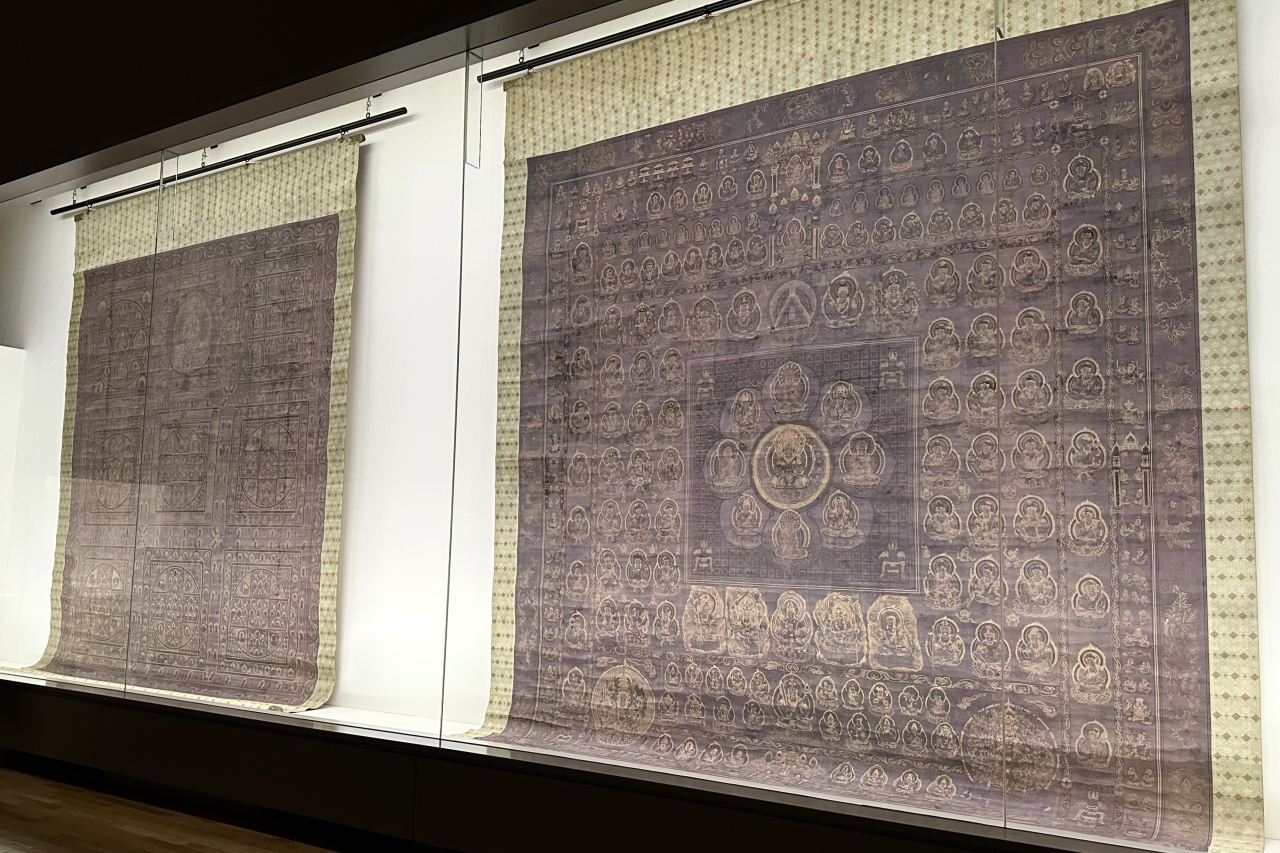
“Ryokai Mandala” On the right is the “Tanzoukai” from the Edo period, 1795 (Kansei 7), and on the left is the “Kongokai” from the Edo period, 1794 (Kansei 6). Owned by Jingoji Temple in Kyoto. On display throughout the year.
On the same floor, a full-sized copy of the Takao Mandala created during the Edo period is also on display. Both of these paintings are on display throughout the year. Compared to the original, which is noticeably damaged, the lines and the vivid colors of the silk are clearer, and the elegant atmosphere of the original is beautifully expressed, so it’s a must-see to compare them together.
If you would like to know more about the appearance of the various deities, you can refer to the Takao Mandala Images, which are ink outline copies of the images, or to the explanatory video shown in a separate room.
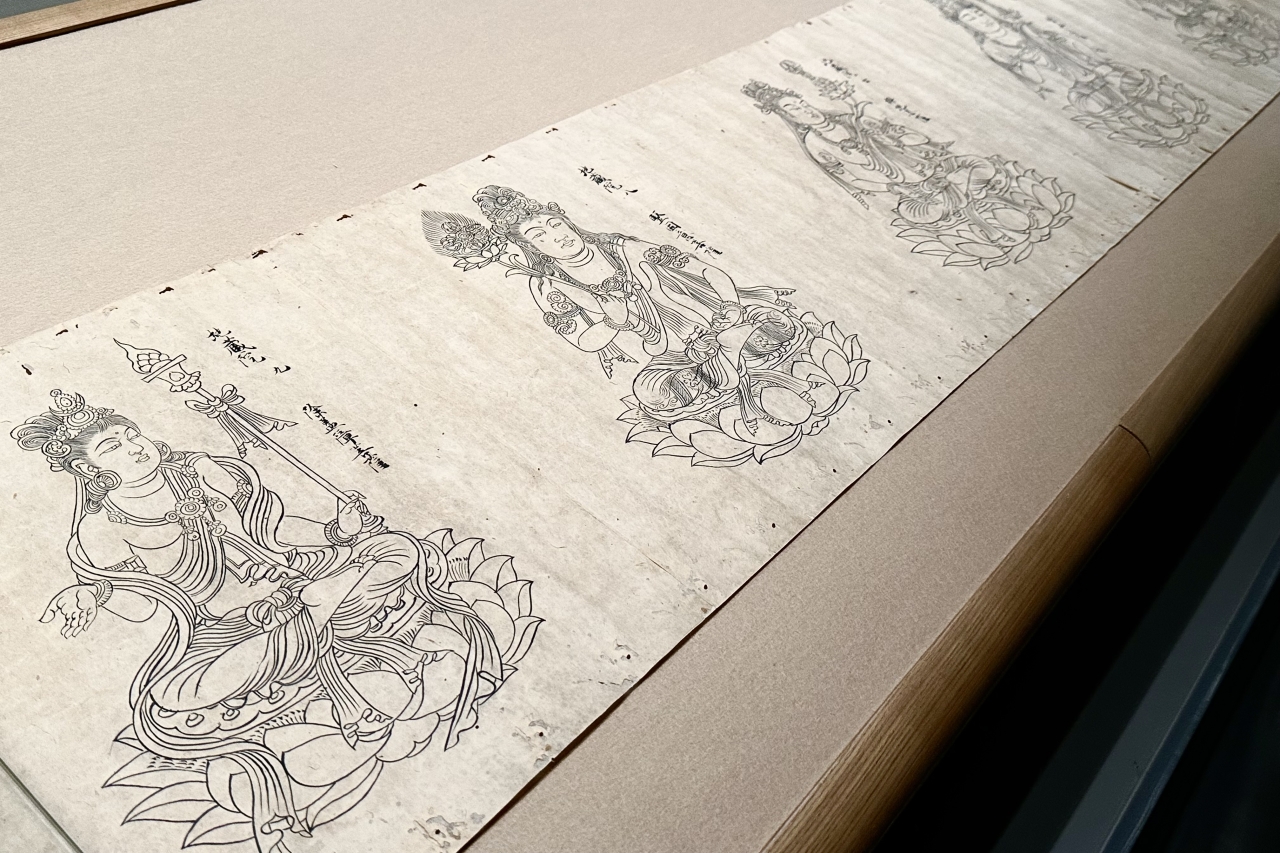
Important Cultural Property “Takao Mandala Image” Heian period, 12th century, owned by Hasedera Temple, Nara. Image is from the first half of the exhibition “Taizōkai Volume 3”
There are records of two repairs to Takao Mandala in the past: the first was carried out by Emperor Gouda in 1309 during the Kamakura period, and the second was carried out by Emperor Kokaku and Emperor Gosakuramachi in 1793 during the Edo period. This is the third time the mandala has been open to the public, after undergoing major repairs for the first time in about 230 years, which took place from 2016 to 2022.

National Treasure “Takao Mandala Imperial Renovation Record” written by Emperor Gouda, Kamakura period, Enkei 2 (1309), owned by Daikakuji Temple, Kyoto, first half of the exhibition
Exhibits such as the old storage box for the Takao Mandala, which contains notes on the two repairs, and the restoration notes written by Emperor Go-Uda himself, convey some of the feelings and faith of our ancestors who wanted to pass on the Takao Mandala, which is considered the foundation and model of mandalas handwritten by Kukai, to future generations.
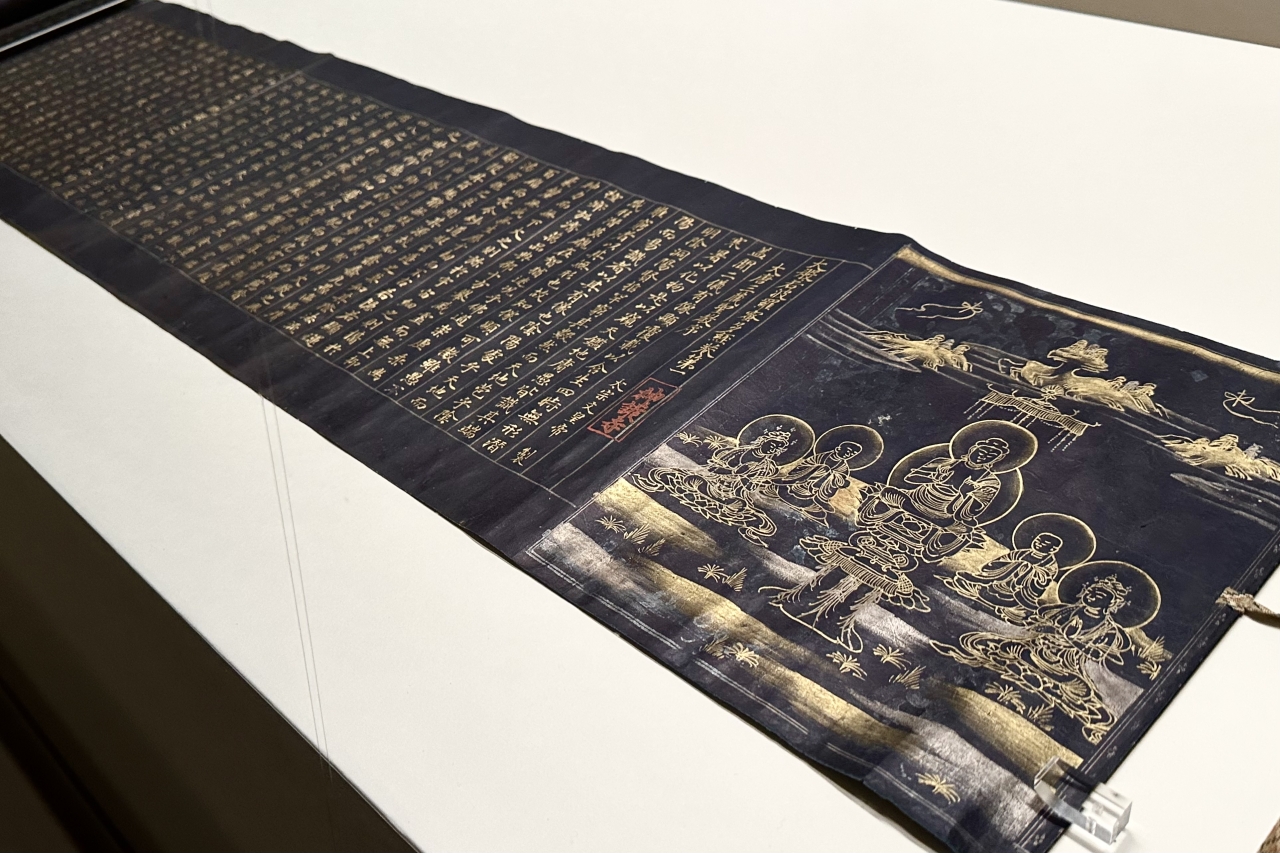
Important Cultural Property “Great Perfection of Wisdom Sutra”, Volume 1 (among all sutras with gold letters on navy blue paper), Heian period, 12th century, owned by Jingo-ji Temple, Kyoto, on display throughout the year/A beautiful sutra with gold paint shining on a navy blue background, which was made at the request of Emperor Toba and donated to Jingo-ji Temple by Emperor Goshirakawa.
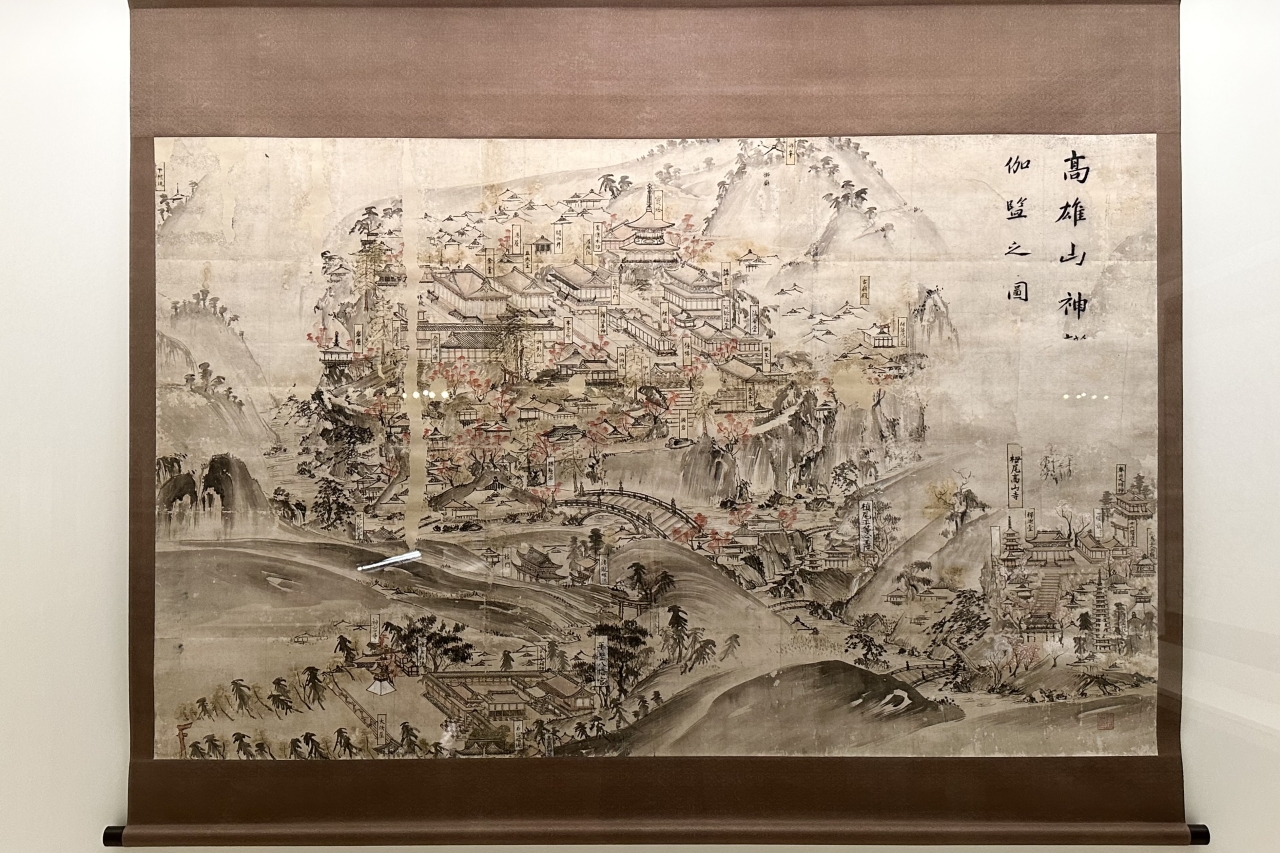
“Map of the Jingo-ji Temple Complex on Mt. Takao” Muromachi period, 15th century, owned by Jingo-ji Temple, Kyoto, on display throughout the year / A medieval guide map that uses mainly ink painting to depict in detail the Jingo-ji Temple complex.
A special exhibition room with impressive statues has also been created! The stern gaze of the principal image, the Yakushi Nyorai standing statue, is piercing
In the second half of the exhibition, a wave of sculptures from Jingoji Temple appears on display.
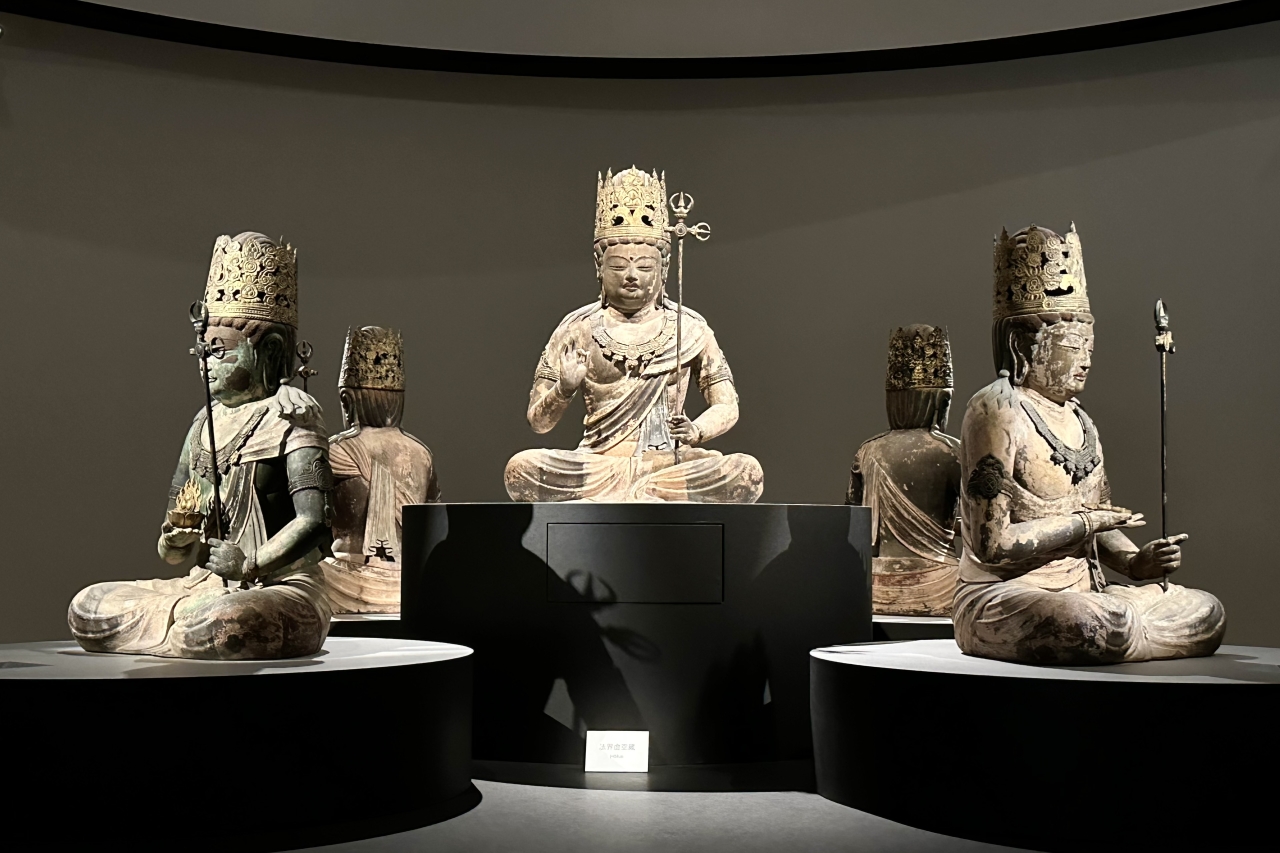
National Treasure “Five Great Seated Kokuzo Bosatsu Statues” Heian period, 9th century, owned by Jingoji Temple, Kyoto, on display throughout the year
The oldest esoteric Buddhist statues at Jingo-ji Temple, the Five Great Seated Kokuzo Bodhisattvas , were erected by Kukai’s disciple Shinzai at the request of Emperor Ninmyo as Buddha statues to be placed in the pagoda. These secret Buddha statues are open to the public twice a year at Jingo-ji Temple, and this exhibition marks the first time that all five statues will be displayed together outside the temple.
The Five Great Kokuzo Bosatsu are said to be five parts of the virtue of Kokuzo Bosatsu, who endows people with infinite wisdom and good fortune, or to be the incarnations of the Five Wisdom Buddhas of the Vajrayana Realm. This work is thought to be modeled after early esoteric Buddhism iconography such as the Takao Mandala, and the highlights are the refined facial features with long, narrow eyes and plump lips, as well as the expression of fleshiness.
It is said that for Kukai, this in itself was a kind of mandala, and at the venue, the four statues were arranged in a circle with Hokkai Kokuzo at the center, creating the appearance of a three-dimensional mandala. When you stand in front of it, you feel as if you are enveloped in a mysterious atmosphere created by the almost identical seated statues.
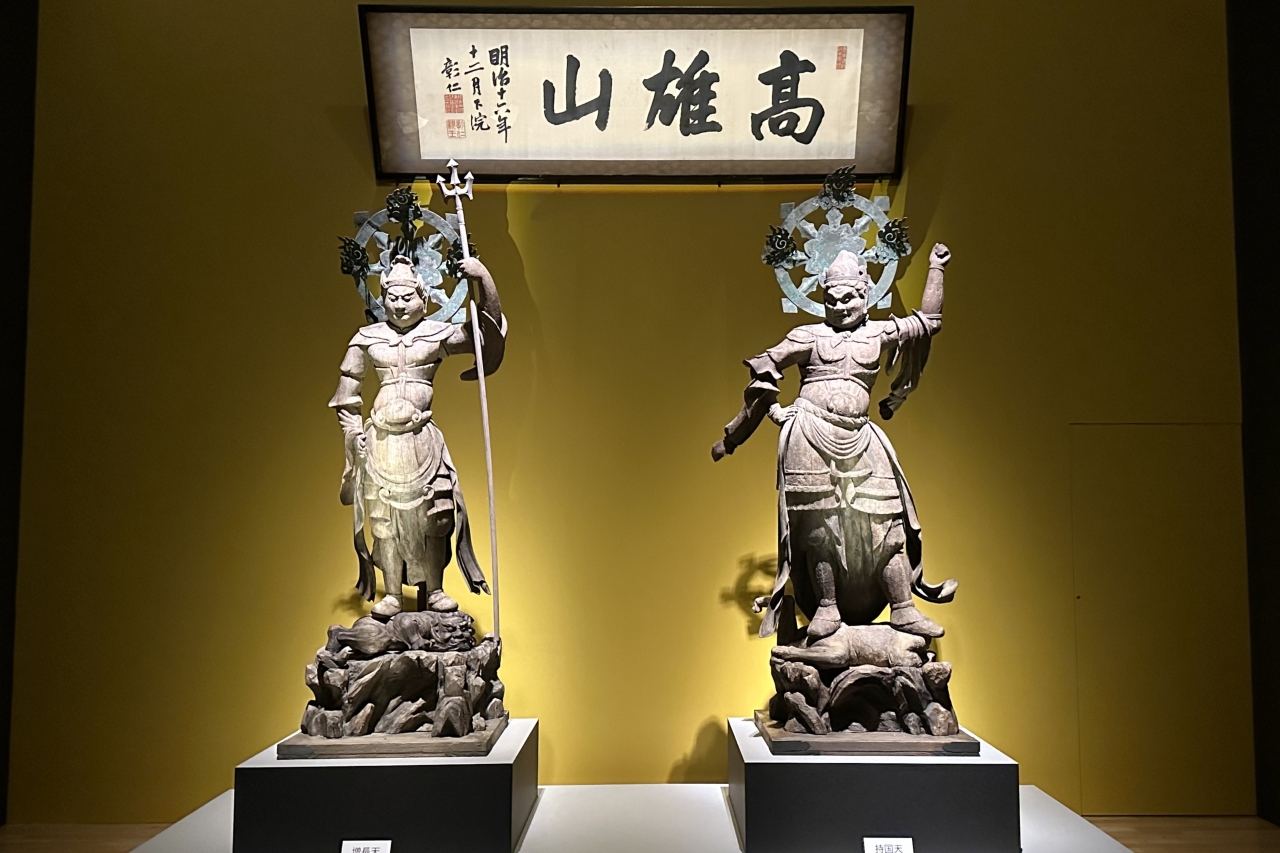
“Standing Statues of Two Heavenly Kings” Heian period, 12th century, Jingo-ji Temple, Kyoto, on display throughout the year / A pair of statues of two heavenly kings welcome visitors at the tower gate at the end of the long staircase of Jingo-ji Temple. This exhibition is the only photo spot.
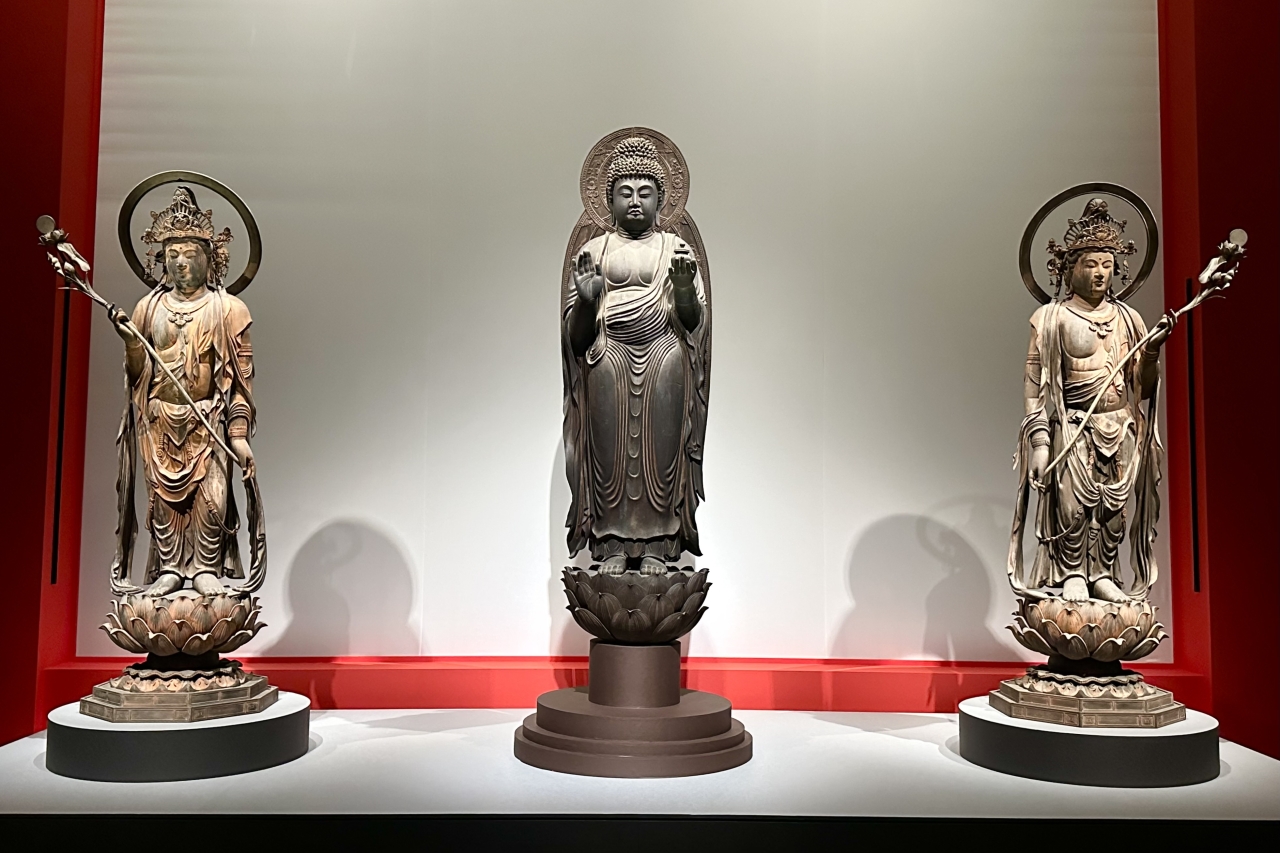
From the left: Important Cultural Property “Standing Gekko Bodhisattva” Heian period, 9th century; National Treasure “Standing Yakushi Nyorai” Heian period, 8th-9th century; Important Cultural Property “Standing Nikko Bodhisattva” Heian period, 9th century. All are owned by Jingoji Temple in Kyoto and are on display throughout the year.
The final exhibition room is lined with only masterpieces of standing statues, creating a solemn atmosphere. In the center is the principal image of the temple, the “Standing Statue of Yakushi Nyorai,” which is also on public display outside the temple for the first time. It is not an esoteric Buddhist statue, but is thought to have been enshrined at one of the temple’s predecessors and was brought to Jingoji by Kukai.
Many unique Buddhist statues were created between the end of the 8th century and the beginning of the 9th century, but this statue stands out among them all. Its greatest feature is its stern gaze that makes you instinctively straighten your posture. Combined with its firm mouth, it exudes dignity.

National Treasure “Standing Statue of Yakushi Nyorai” Heian period, 8th-9th century, owned by Jingoji Temple, Kyoto, on display throughout the year
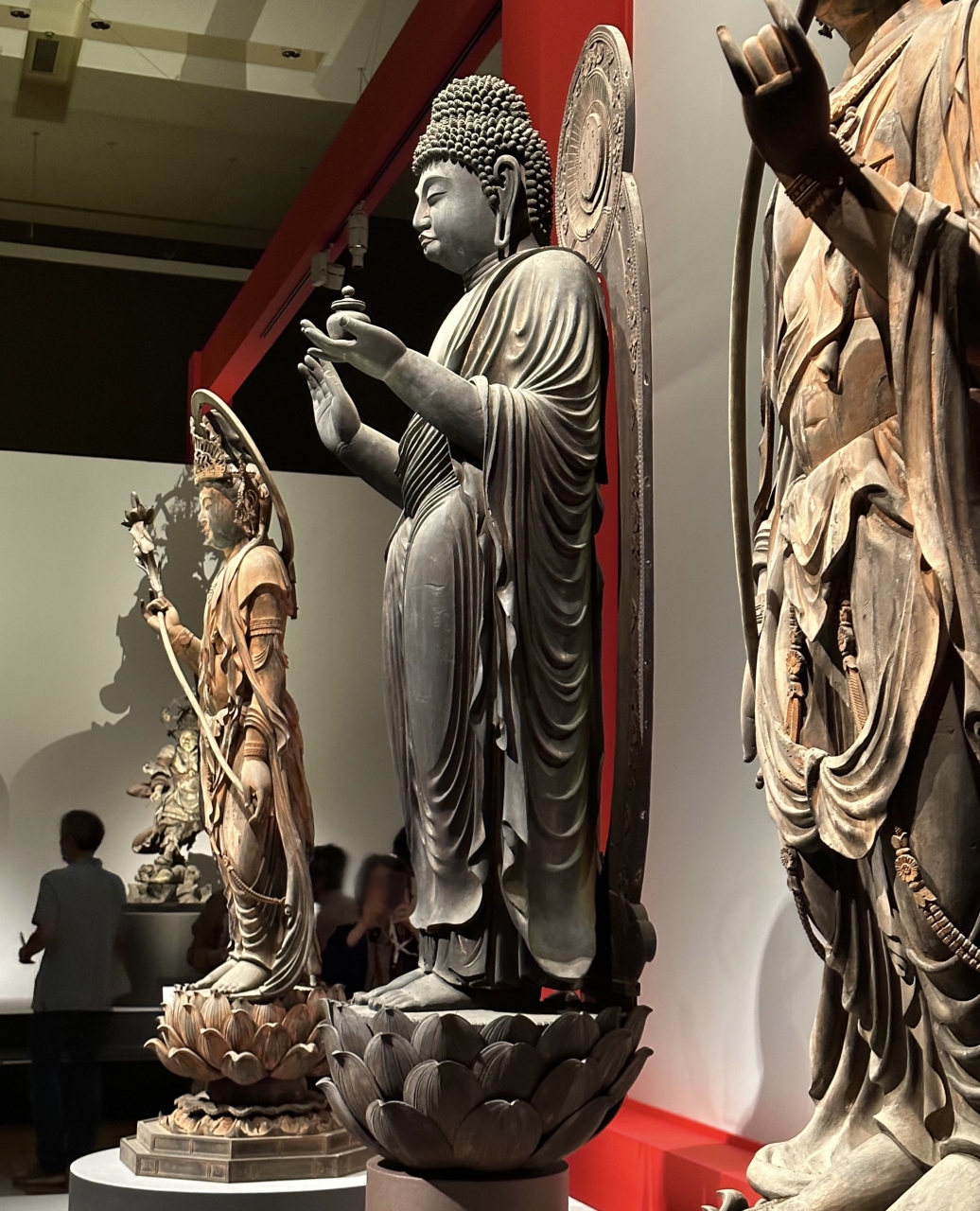
National Treasure “Standing Statue of Yakushi Nyorai” Heian period, 8th-9th century, owned by Jingoji Temple, Kyoto, on display throughout the year
One of the great attractions of this exhibition is that it allows visitors to enjoy the beauty of the sculpture, which can usually only be viewed from the front as it is enclosed in a shrine at Jingoji Temple, from a variety of angles.
The statue is carved from a single piece of wood, excluding both arms, and its thighs, which overhang more than one would imagine from the front, emphasize its thickness. The left sleeve is decorated with a honpashiki fold pattern, which alternates between large round waves and small, ridged waves, and the depth of the carving creates an even more profound feeling. The honpashiki fold pattern is a characteristic of early Heian sculpture, but it is said that it is rare to see such a beautiful and clear statue.
Why did Kukai choose this statue, which is not an esoteric Buddhist statue, as his principal image? The reason is unclear, but Shiro Maruyama, a researcher at the Tokyo National Museum, explains as follows:
“Even more than Esoteric Buddhism placed great importance on form, I believe Kukai himself probably had a deep interest in form from the start. How did Kukai feel when he received this statue? I hope this exhibition will give you the opportunity to think about it.”
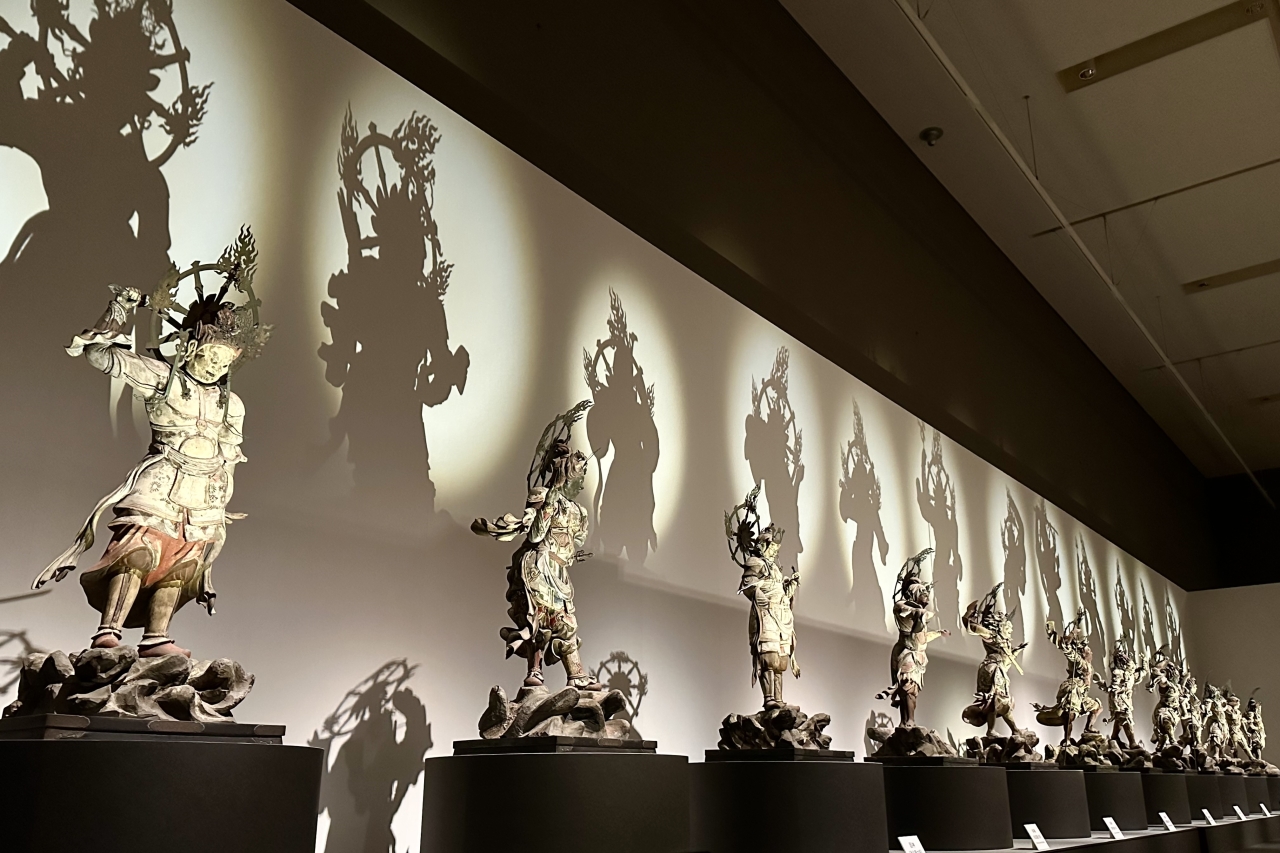
Standing Statues of the Twelve Heavenly Generals, by Yoshino Ukyo and Ohashi Sakuemon, “Rooster God, Boar God” Muromachi period, 15th-16th century, “Child God – Monkey God, Dog God” Edo period, 17th century, owned by Jingoji Temple, Kyoto, on display throughout the year
Surrounding the main image are the Four Heavenly Kings and the Twelve Heavenly Generals . At Jingoji Temple, they are placed close together, but here they are spaced out and spaced apart. Furthermore, the lighting makes the silhouettes of the statues, which are in unique poses, stand out in the background, beautifully highlighting their dynamic expressions. It was such a spectacular sight that I was entranced for a while.
The special exhibition “Jingo-ji Temple – Kukai and the Origins of Shingon Esoteric Buddhism,” where you can experience the spirit and thought of Kukai, will be held until Sunday, September 8, 2024.
Summary of the special exhibition commemorating the 1200th anniversary of the temple’s founding, “Jingo-ji Temple – Kukai and the origins of Esoteric Shingon Buddhism”
| Dates | July 17th (Wednesday) – September 8th (Sunday), 2024 |
*Some of the works on display will be changed during the exhibition.
Early exhibition: July 17th (Wednesday) – August 12th (Monday/Closed)
Second half of the exhibition: Wednesday, August 14th to Sunday, September 8th Venue: Tokyo National Museum Heiseikan Opening hours: 9:30-17:00
* Open until 7:00pm on Fridays and Saturdays (except August 30th and 31st)
*Entry is permitted until 30 minutes before closing. Closed on Mondays and August 13th (Tuesday)
*However, the museum will be open on August 12 (Monday, closed day) *The general cultural exhibition will open on August 13 (Tuesday) Admission fee (tax included): Adults 2,100 yen, University students 1,300 yen, High school students 900 yen
* Free for junior high school students and younger, people with disabilities and one caregiver.
*No advance reservation (specified date and time) is required.
*You can also view the General Cultural Exhibition with your ticket for this exhibition on the day of the event.
For more details, please visit the official website of the exhibition. Organizers: Tokyo National Museum, Takaosan Jingoji Temple, Yomiuri Shimbun, NHK, NHK Promotions Contact: 050-5541-8600 (Hello Dial) Official website: https://tsumugu.yomiuri.co.jp/jingoji/
*The contents of this article are current as of the time of coverage. Please check the official exhibition website for the latest information.
<Past interview articles>
[National Museum of Western Art] “Naito Collection Manuscripts – A Microcosm of the Elegant Middle Ages” Coverage Report


